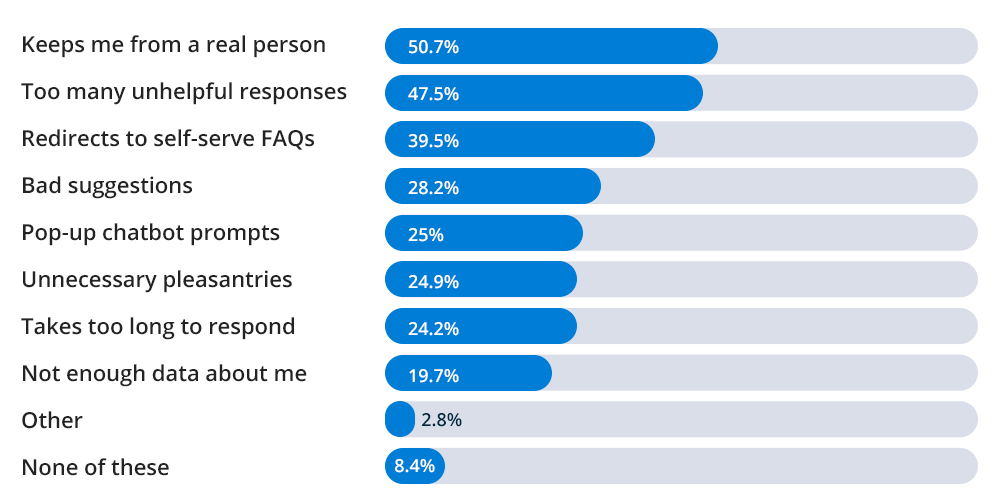TL;DR
- Chatbots have got a bad reputation, but if you set them up properly, the opportunty they provide is massive.
- By 2024, Chatbot revenue is predicted to reach over 2.1 billion U.S. dollars.
- Want to avoid pitfalls? Remember, don’t be creepy.
- Set up your Chatbots to be helpful and provide information that takes up too much of your employees time. Then, transfer them to a human when they need them.
Chatbots allow your customers to communicate with an Artifical Intelligence (AI) in place of a regular old fleshy human being. This offers you an attractive prospect: keep your costs down while still improving the customer experience.
Specifically, chatbots can work wonders for your online advertising strategy.
But while there is a clear path to success, there are some pretty huge pitfalls that need to be avoided along the way.
Read on for your roadmap.
Chatbot Teething Problems
Initially, chatbots had a pretty terrible reputation. And you know what sucks? Getting the blame for something that isn’t your fault.
Let’s explain. In the Science Fiction classic 2001: A Space Odyssey, an AI named HAL was tasked with controlling a spacecraft called Discovery One.
HAL ends up killing several sleeping crew members and then attempts to kill the rest too. But HAL was only doing what it was programmed to do: finish the mission at all costs. Human life was regarded as expendable.
Sure, no company has yet managed to create a chatbot capable of killing people. But early forays into chatbot technology were marred by some pretty spectacular failures.
These failures were caused by poor planning, poor execution – and in some cases an unholy combination of the two. This is not the place for listing other people’s mistakes, but a simple Google search will reveal some pretty poor utilisation of chatbots. Here’s just one example.

Weighing up the risk of causing damage to your brand, are chatbots worth your time and effort?
The short answer is a resounding, emphatic, all-conquering YES.
The longer answer? Well, if you set your chatbot up properly and sidestep easy-to-avoid pitfalls, the opportunity is massive.
The Capacity For Greatness
There’s a very good reason we included chatbots as an example of how you can get ahead in 2019. Let’s dig in.
In 2017, Zion Market Research calculated that chatbot market revenues were sitting at 370 million U.S. dollars. Using the same data, they forecasted that by 2024 this number will have exploded to over 2.1 billion U.S. dollars.
In May 2018, Sumo Heavy dropped some pretty eye-opening figures for us. Here are the headlines:
- Just 11% of consumers had tried shopping through chatbots.
- Only 37% of consumers had interacted with a messaging chatbot.
- 42% of consumers were entirely unfamiliar with the concept of “conversational commerce” (mixing messaging apps with shopping).
But after using them:
- 72% found the experience helpful and informative
- 6% found the experience complex and confusing.
From all this, there are two key takeaways. One, there’s massive potential for revenue. Two, while chatbots are still new and unfamiliar to many consumers, a huge percentage of them find the experience beneficial.
Big money potential? Check. Good experience for customers? Check.
So, if you’re calculating your marketing budget and looking for a fantastic way to spend some of it, Chatbots might be the way forward. The only thing we have to do is avoid being one of the spectacular failures we talked about earlier.
Avoiding Trouble
Let’s look at the data. eMarketer conducted a study that focused on the challenges of using chatbots.
The results were:

I Don’t Want A Robot, I Want A Human
At first glance, keeping someone from a real person might seem like an unassailable problem. But remember the data from above? Consumers are wary of chatbots because the benefit to them isn’t clear yet.
Sure, chatbots aren’t ready to replace human beings for certain areas of your business – for example, where customers need to make a complaint. That said, chatbots are ready for online advertising right now.
We put together an article on managing churn rates, and it’s all about letting your customers know you care about them. With Chatbots, this is doubly true.
It’s best to remember two core principles: manage expectations and don’t be creepy. Before you implement anything, use these two concepts as lights to guide your way.
But how do you implement them? Let’s get to that.
Communicate openly with your customers. Tell them they’re using a chatbot. Offer a human alternative (if you can). Explain the benefits (SaleBot 5000 is available 24/7, knows our product list inside out, can recommend a purchase, etc.). And don’t try to be too clever or weird.
We’re going for helpful and informative (the 72% from above) – not complex and confusing (the 6%).
Unhelpful Responses, Bad Suggestions, Not Enough Data About Me
Again: don’t be creepy.
If a chatbot interacts with you and says, “Hi Jess, I can see from your browsing history you like ice hockey, baseball, horror films and seafood. Can I interest you in…” then you’ve already failed.
At best, your customer is surprised – and not in a good way.
More likely? They’re irritated, disengaged, concerned and/or confused.
In spite of this, much of the negative feedback concerning chatbots centres on a lack of useful and relevant information.
So, we need to know all about our customers BUT not use any information we have gathered from their browsing experience. Our chatbot needs to offer useful information without being weird. How do we manage this?
It’s really simple. We make sure we’re the opposite of creepy. We’re upfront and honest. We’re helpful and informative. We explain to consumers what our chatbot is doing and why – and we tell them the benefits of this.
Better yet, we just ask the consumer what they want. We prompt them and start a conversation. We let our customers volunteer the information we need. We’re upfront about everything; we’re helpful and informative.
Putting This Into Practice
Right, so with your guiding principles in place, how do we make it work for online advertising?
Generating And Assigning Leads
Roof.ai absolutely nails this. Check out this example of an interaction between a customer and the roof.ai chatbot.

This chatbot has automated the process of interacting with leads altogether. It’s identified potential leads via Facebook, responded almost instantly in a friendly, helpful and conversational tone. It’s been upfront about the fact that it’s a bot. Based on some user input, it prompts for a little more information.
The estate agents benefit from this in multiple ways. They don’t need an expensive human to do a relatively simple task. There’s no risk of an overworked sales agent missing a lead by failing to respond to one of many Facebook messages. Responding to user queries immediately is also likely to increase conversions.
This can work for any business that needs to classify leads, push consumers into the correct sales funnels and setup customer relationships instantly. Whether you’re selling haircuts, board games or luxury holidays, a chatbot of this nature is going to be a useful tool.
Create a helpful and informative bot. Make it honest. Make sure it’s not creepy. Advertise the bot. Setup the customer relationship. Hand over to the humans. Win.
Engage Your Audience With A Conversation
The web is littered with chatbot technology. wayblazer.ai tells you to “rethink how you advertise” because “traditional ads are dying”. It provides an example where a chatbot ad says “Hi, chat with me about your next vacation” in place of a regular display ad.
Their example doesn’t make it clear enough that the consumer is interacting with a bot, but it does follow our other principles pretty closely. And the benefits of this chatbot are gigantic:
- It’s creating personalised ads with user-input – and it’s not being creepy (beach holidays, city breaks, etc.)
- It’s allowing people who see the ad to explore products without disrupting their browsing experience.
- It’s providing an instant, on-brand experience.
- It’s pulling data from each ad session to understand how guests are searching for your offerings.
- It’s managing expectations for customers before they’ve even visited your site.
Get this right and you will go far. It’s something that will work regardless of industries. Whether you’re selling emergency plumbing or trainers, this will work for you too.
Conversational Marketing Will Be King
By 2020, it’s predicted that 85% of consumer interactions will be handled without a human agent. In regards to e-commerce, 34% of respondents to a recent study said they would prefer to answer questions from AI via chatbots of virtual assistants over a person.
This percentage will probably increase very quickly too. Why? Because people don’t like pushy salespeople. They don’t like being upsold to. An open, honest chatbot providing good information 24 hours of the day is likely to be better for customers.
Therefore, it’s no surprise that 80% of businesses plan to have their own chatbot by 2020 and it’s a pretty good idea to have a ticket on that train. Chatbotize, for example, have created something excellent which fits this mould.
The best option right now is Facebook’s Click-to-Messenger Ads. While Whatsapp is the dominant force in the messaging market, Facebook Messenger is just behind and it’s much easier to integrate conversational marketing with Facebook Messenger.
Better yet, there are some pretty intuitive Facebook chatbot builders out there – Landbot is one of our favourites that can help you set one up.
Love it or hate it, Chatbots will become the norm and they are one of three ways you can get ahead with online advertising in 2019. Follow the principles outlined above and use them to drive forward with your online marketing.
Let’s remember the core message. Be helpful and informative. Be honest. And, above all else, don’t be creepy.
If this all sounds like a little too much hard work, it might be worth having a quick chat with our own friendly chatbot here at Adzooma.



